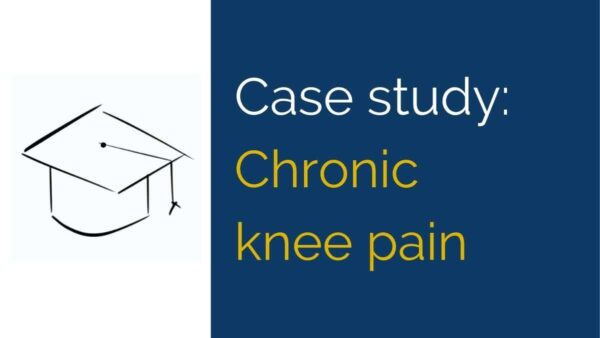Background – Chronic knee pain
This case study on chronic knee pain focuses on linking findings in the history, examination and imaging to the patient’s presentation and symptoms. It also encompasses the development of a rehab plan based on examination findings.
Minimum Level
New graduate Physiotherapist and Physiotherapy student
History
Cassandra is a 52 year old active lady with a five year history of Left chronic knee pain
Does the unilateral nature and duration of the symptoms influence your clinical reasoning on diagnosis or the likely cause?
Mentor’s reasoning:
The pain can be felt medially or anteriorly, but rarely in both locations
What’s an explanation for the two seemingly independent locations of pain?
Mentor’s reasoning:
The symptoms are more noticeable going downstairs, after a long day at work in a retail setting and after running
Does this influence your diagnostic hypotheses?
Mentor’s reasoning:
There is some swelling around the knee after exercise
What is a common secondary pathology due to chronic knee swelling?
Mentor’s reasoning:
Cassandra’s doctor organised an Xray which showed:
- some loss of joint height in the medial compartment
- osteophytes at the medial tibiofemoral and patellofemoral joints
- there was no subchondral pitting evident
Does this Xray change your approach to designing a rehabilitation plan?
Mentor’s reasoning:
Based on the Xray results, the doctor prescribed Celebrex 200mg, one tablet once per day
What effect would you expect from this medication?
Will it help or hinder your rehab?
Mentor’s reasoning:
Cassandra’s goals are to return to running 5km three times per week without discomfort or flaring her chronic knee pain
Is this goal realistic? What information are you using to form that opinion?
Mentor’s reasoning:
Objective assessment

Anatomical overview
Identify key anatomical structures around the knee that are relevant to this case.
Name all of the anatomical structures shown in the picture – there are around 20 structures shown.
(Note that the circulatory, lymphatic and nervous systems have been omitted from the image to focus on musculoskeletal structures.)
Examination
You notice that Cassandra has bunions (Hallux Valgus), more prominent on the Left than the Right
Does the formation of a Bunion suggest any causative biomechanical issues for the chronic knee pain?
Mentor’s reasoning:
Cassandra’s BMI is 27.5, which she tells you is improving after a mid-COVID weight gain due to inactivity
Is Cassandra’s weight a factor in her presentation or rehab planning?
Mentor’s reasoning:
Cassandra is able to perform a half depth bodyweight squat without any pain or difficulty
During a single leg squat, the chronic knee pain is noted across the medial joint line and remains consistent with each repetition
Comment of these two tests and how they affect your clinical reasoning
Mentor’s reasoning:
Knee range is lacking around 5 degrees of extension and around 15 degrees of flexion on the Left knee compared to the Right knee
What’s the most likely explanation for the loss of knee range?
Mentor’s reasoning:
Passive hip rotation range in sitting (90 degree hip flexion) is 45 degrees of internal rotation and 50 degrees of external rotation, right = left
How does that compare to what you would expect?
Mentor’s reasoning:
McMurrays test does not induce a click but is painful throughout an arc of movement
Is this test positive and what does it indicate?
Mentor’s reasoning:
There is tenderness on palpation across the medial tibiofemoral joint line but no tenderness around the patellofemoral joint
Comment on the implications from this finding
Mentor’s reasoning:
Further information
What further questions would you ask or use to clarify the above information?
What are you hoping to gain from these questions?
Mentor’s reasoning:
What further tests would you perform and why?
Mentor’s reasoning:
Initial plan for rehab
Based on the above information, design a basic outline of a rehab plan for Cassandra’s chronic knee pain.
Include features of the case to justify each component of your management.
Mentor’s reasoning:
Like to continue the conversation? Head over to our Facebook page.

